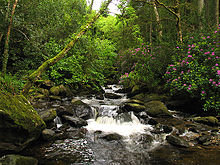Killarney National Park
[1] The park has since been substantially expanded and encompasses over 102.89 km2 (25,425 acres) of diverse ecology, including the Lakes of Killarney, oak and yew woodlands of international importance,[2] and mountain peaks.
[5] The park is of high ecological value because of the quality, diversity, and extensiveness of many of its habitats and the wide variety of species that they accommodate, some of which are rare.
The underlying geology of the majority of the park is sandstone, with the limestone pavements occurring on the low eastern shore of Lough Leane.
[12] Killarney National Park is one of the very few places in Ireland that has been continuously covered by woodland since the end of the most recent glacial period,[13] approximately 10,000 years ago.
[14] Muckross Abbey was founded in 1448 by Observantine Franciscans and is also still standing, despite having been damaged and reconstructed several times when its inhabitants were raided.
[13] The biggest cause of oakwood destruction in Killarney in the 18th century was the production of charcoal to fire smelters used in the local iron industry.
[15] In 1780 Young famously described Derrycunihy wood as "a great sweep of mountain, covered partly in wood, hanging in a very noble manner, but part cut down, much of it mangled, and the rest inhabited by coopers, boat-builders, carpenters and turners..."[13] Woodland exploitation again increased during the Napoleonic era in the early 19th century, probably because of the high prices that oak was commanding at this time.
[13] As most of the oak trees in the woods today are around 200 years old, it is likely that the majority of them were planted, and the oakwoods that have never been disturbed by humans are restricted to a few isolated pockets in remote areas such as mountain valleys.
The Herbert's financial situation became precarious in the late 19th century,[16] and the Muckross estate was purchased by Lord Ardilaun of the Guinness brewing family in 1899.
In 1910, the American William Bowers Bourn bought Muckross Estate as a wedding present for his daughter Maud on her marriage to Arthur Vincent.
[7] Initially the Irish Government was unable to provide much financial support to the park, so it operated primarily as a working farm that was open to the public.
[8] Almost 60 square kilometres (15,000 acres) has been added to the original park, including the three lakes, Knockreer Estate, Ross Island, Innisfallen, and the townlands of Glena, Ullauns, and Poulagower.
To prevent further pollution causing a permanent change in the lake's ecosystem, a review of land use in the catchment area is being carried out.
[6] As of August 2007, several large hotels and businesses have stated their intention to stop using phosphate detergents, in an effort to preserve the quality of the lake water.
[15] The woods have Annex I status in the EU Habitats Directive because of their diverse and rich flora, most notably their bryophytes (mosses and liverworts).
[3] The remote Glaism na Marbh valley has a particularly rich flora of bryophytes, some of which are scarce or absent in other parts of the woods.
[15] Rare species growing in the woods include Cyclodictyon laetevirens, Daltonia splachnoides, Lejeunea flava, Radula carringtonii, and Sematophyllum demissum.
[6] Bird species that reside in the oak woods include blue tit, common chaffinch, goldcrest, European robin, and wren.
Insects include many species of the parasitic gall wasp and the purple hairstreak butterfly, whose caterpillar is entirely dependent upon oak trees.
[23] Yew is a native evergreen tree that grows best in the high humidity of mild oceanic climates, which makes Killarney a very suitable location.
Overgrazing of the woodland floor by sika deer may be part of the reason for this, but small areas of the wood that have been fenced off since 1969 have experienced very little yew regeneration.
[24] Wet woodland (also called carr) on the low-lying swampy limestone areas within Lough Leane's floodplain is about 1.7 square kilometres (420 acres) in size.
The dominant canopy species here are alder (Alnus glutinosa), ash (Fraxinus excelsior), downy birch (Betula pubescens), and willow (Salix spp.).
The bogs also support a number of notable species, including mosses (Sphagnum pulchrum, S. fuscum, S. platyphyllum, S. strictum, S. contortum and Calliergon stramineum), liverworts (Cladopodiella francisci and Calypogeia azurea) and lichens (Cladonia mediterranea, C. macilenta, C. rangiferina, C. arbuscula and Cetraria islandica).
[3] Several of the animal and plant species in the park have a hiberno-lusitanean distribution, meaning that they only occur in southwest Ireland, northern Spain, and Portugal.
Significant amounts of plant species found in the park have unusual geographic distributions and are of localised occurrence within Ireland.
[6] The park has Ireland's only remaining wild herd of native deer (Cervus elaphus hibernicus), comprising approximately 900 individuals.
[3] These species include redwing, fieldfare, golden plover and waterfowl such as teal, goldeneye, wigeon, pochard and whooper swan.
A small flock of Greenland white-fronted geese (Anser albifrons flavirostris) from the world population of approximately 12,000[4] migrates to winter on boglands[6] in the Killarney Valley within the park.
[6] Pressures from native grazers like red deer and Irish hare have increased since their main natural predators, the wolf and golden eagle, became extinct.












